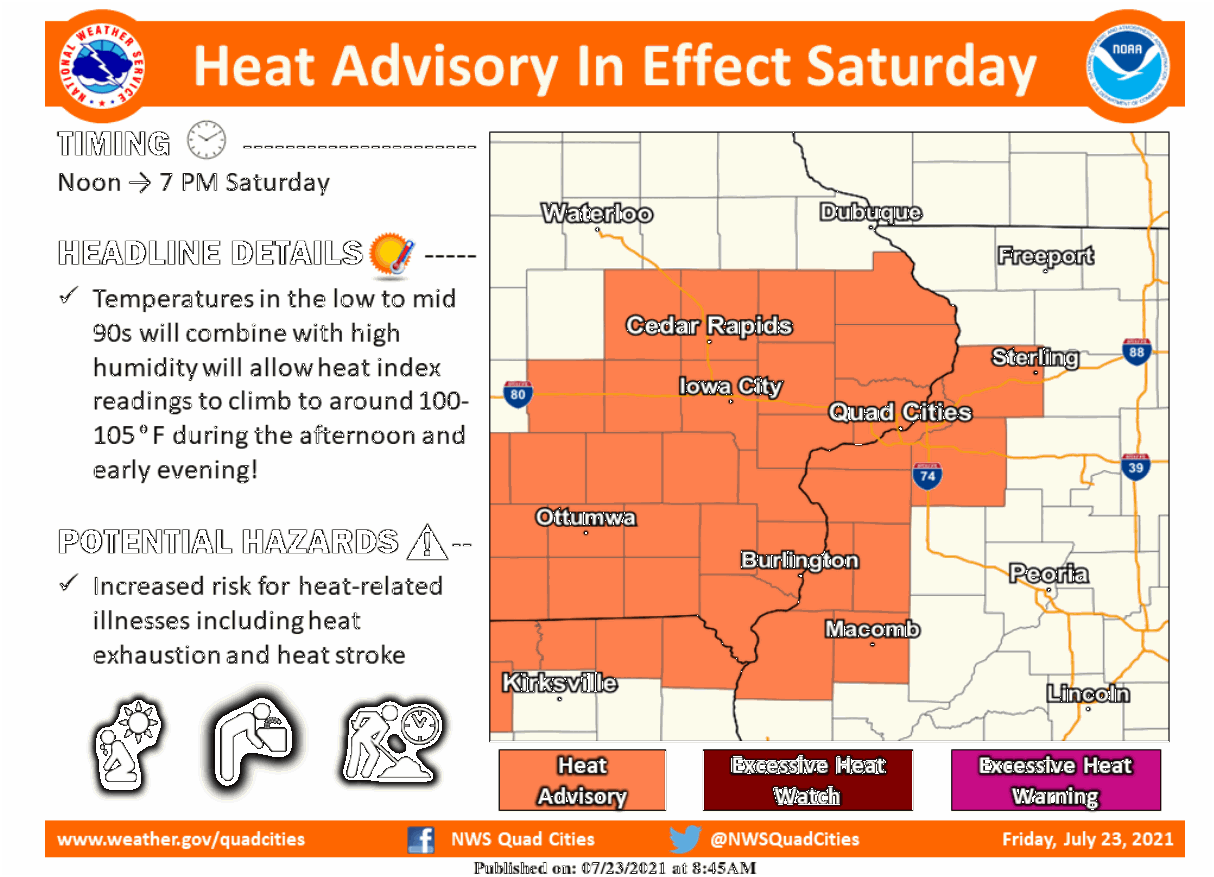THE MJO LEADS THE PACK...
If you've been following along lately you know that I've been questioning the strength of a heat wave the models had been advertising for much of next week. The MJO (Madden Julien Oscillation), a teleconnection that often sees trends before the deterministic models, is depicted by both the GFS and EURO to pass through phase 6 during that period. Phase 6 in July portends temperatures that look like this. That's not what you look for in a heat wave.

The fact models have not been portraying what their MJO forecasts were indicating has been troubling me for days. While the GFS was showing signs of trending cooler, the EURO has been adamant about running the heat through this weekend and right on into the next one (unabated). Look what the EURO was indicating for highs as recently as Thursday. This is from July 24th through August 1st, it had highs in the 90s everyday with a 100 July 31st.

My contention (based heavily on the MJO) was that with the NW flow around the heat wave it was quite conceivable that short waves rotating around the heat wave could develop MCS clusters (thunderstorms) that could generate relief producing back door fronts from time to time. My feeling was we would see the first break Sunday and Monday in the form of lower humidity. Temperatures would not be that much cooler but it would feel a lot better due to the drier air. After that I expected heat and humidity to make another run midweek before a stronger short wave forced the whole pattern to retrograde west bringing significantly cooler conditions later in the week.
All it would take is one good short wave to buckle the NW flow and set it all up. At least for now you can see how the pattern is moving towards the idea of less heat with the jet showing that nice mid-week buckle and the emerging cool-down.

You can also see how much stronger the trough (above) is over the Great Lakes and NE than 24 hours earlier (below).

Notice what the GFS is now depicting for highs. Through August 2nd the average high over the 10 day period is 85 degrees, with next Friday at 78. Yesterday the EURO was was producing a 100 degree high on July 31st, Friday night the GFS is down to 81.

The GFS is now indicating these temperature departures next Thursday. Some nearly 25 degrees below normal. (A cautionary note, this is highly contingent on clouds and precipitation which is far from a sure thing). However, this is a far cry from the 9 consecutive days in the 90s the EURO showed.

The 5 day average temperature departures which are more reliable still show well below normal readings from Wednesday into next weekend.

That looks a lot more like the way phase 6 of the MJO should look like and I think the GFS idea has validity.

If the GFS does verify that is a big win for the model over the EURO. My point in this exercise is to show what a valuable tool the MJO can be to sniff out trends before the deterministic models can ingest good enough data to catch it themselves. It's given me a 3 day notice that things were not as clear as models indicated. There is still a window for things to vacillate in coming days but I do feel confident chances of extreme (and especially prolonged heat) have lowered. Not to say it won't be warm because it will be, but in general it won't be anything out of line for the peak of summer.
The last thing I will tackle is the potential for any storms with the first front that brings lower humidity Sunday and Monday. Before it arrives, Saturday is going to be a very sultry day with heat Index values of 100-105 thanks to highs in the low 90s and dew points that peak in the range of 70-75, highest in the south. These are heat index values on the 3k NAM.

Much of the area (as expected for several days) is under a Heat Advisory from noon to 7:00 PM Saturday.

All that heat and moisture creates instability that is measured in CAPE (convective available potential energy). That is formidable in the SE 2/3rds of my area late in the afternoon just ahead of the approaching front.

Levels like that would indicate the potential for some strong updrafts that could produce gusty wind and pockets of heavy downpours. However, shear is weak and there is a stout cap (warm air aloft) that could suppress storm development. There is doubt regarding the strength of the convergence and forcing and whether or not storms will even fire. The 3k NAM says yes somewhere in the central or south towards evening. Our other hi-res convective model designed to see such a thing, the HRRR says no. Below is the line of storms the 3k fires.

SPC does have a slight risk of severe storms in its latest day 1 outlook mainly SE of the Quad Cities.

The point here is that storm chances Saturday evening are up for grabs. The cap is going to be a big player and we'll just need to watch things unfold as Saturday wears on. Just be advised the potential is there.
Eventually the front passes and some very nice relief is anticipated Sunday in the form of drier air. It will still be warm but humidity levels will drop substantially as dew points plummet from the 70s Saturday to the 50s and low 60s. The 3K shows this Sunday afternoon.

If we miss the rains Saturday evening, hopefully we'll have some opportunities next week as short waves round the ring of fire generating a couple of thunderstorm clusters. The pattern is ripe for it. With that, I'm out. Roll weather...TS










